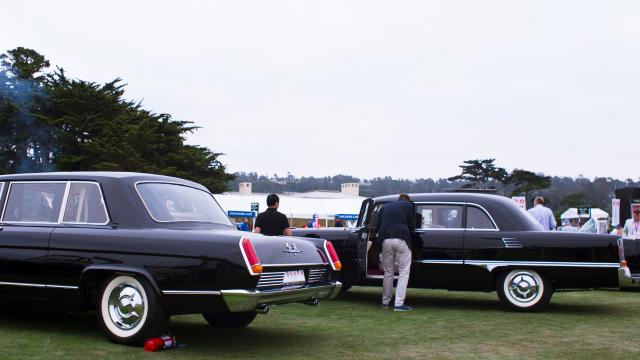In the 1960s, China finally built a luxury car of its own, the Hongqi. But the car was meant for Chairman Mao and other official duties in local governments, and as such, few are ever seen outside of China, or up close at all. But two rolled into the Pebble Beach Concours d’Elegance this year, the first Chinese cars in America’s most prestigious show. And they are fascinating.
The Sanhe Classic Car Museum in Chengdu brought out these two Hongqis, representing the first and second model Hongqi made. The early car is a 1965 Hongqi CA72 and the second is a 1974 Hongqi CA770. I’m trying to be precise with my wording here, as there isn’t a ton of consistent information out there on these cars.
Above is the CA72, below it is the CA770. Note how the later car is more angular. The CA770 has been in the States for about a year now at the Blackhawk Collection. The CA72 here lives in China and its caretakers claim it’s the first of its kind to visit the U.S.
Even the restorers themselves didn’t have a lot to go on, as Dizzy Li, General Operation Manager of Chengdu Xingsanhe Classic Car Rebuilding explained to me on the Pebble Beach lawn. He worked with next to no documents for the CA72, next to no pictures, next to no parts. Lots of the car had to be remade from scratch.
Only about 20 of these early cars still exist, Dizzy told me, from 202 made, versus 800 or so for the later CA770. This doesn’t match what is listed in the car’s information provided by Pebble Beach (10 remaining for the CA72), and it’s a few dozen units from what another CA770 owner puts as the production figure (around 200). It’s from a very distant time in the history of cars in China, from right in the midst of the Cultural Revolution.
We’ve gone over Hongqi history a few times as it’s intriguing, but here’s how our own Jason Torchinsky summed it up when it first came out that these cars would be here:
Hong Qi means “red flag” in Chinese, and is the oldest passenger car maker in (well, post-1949) China, being founded in 1958. Hong Qi’s cars were, like Soviet ZIL limousines, not for regular people to drive, but were reserved for government officials, diplomats, dignitaries, and foreign heads of state. If you meet an elderly Chinese person with memories of riding in a Hong Qi, they’re probably a Big Deal.
There is more to the history as well, with Dizzy explaining that it was a product of the split between the Soviet and Chinese governments from the mid 1950s into the mid 1960s, leaving China without exactly clear ties to the USSR or U.S.A. and their respective vehicular fleets. It lines up with a sense of pride that China would fo in on a car of its own at this time.
Even the museum didn’t say exactly what engine is under the hoods of these cars. They’re V8s, supposedly 5.6-litre units from Chrysler. Which engine, exactly, isn’t super clear. Pictures show what looks to be a Mopar small block, which would line up with the 1960s-era 340, but Chinese car history buff Tycho de Feyter said the car was based on a 1950s Imperial, which never had that engine.
Instead it might have a 5.4-litre Hemi, as Jalopnik alum and Hongqi fan Murilee Martin reported a few years back. but a CA770 recently showed up on Jay Leno’s Garage, in which the Leno figures the car has a Ford V8 of a similar era and the owner agrees and quotes the displacement at 5.7 litres.
I think Dizzy and his team are correct, but it goes to show that finding anything conclusive about this car is a challenge.
The later car has an automatic, the early car is a manual.
Picking out the differences between the cars is a challenge if you don’t have them in front of you. Look at the face of the CA72:
And here is the face of the CA770:
Inside they are more different, but both are wonderfully pretty. They are both spare, but it works in a midcentury modern kind of way. The CA72 has lovely beech wood trim around the doors.
You open them and see the emblem in the center of the steering wheel, a rickshaw.
The rest is just big. It is loungelike.
The CA770 is much more plain, with plastic protective covers left on the benches like in my aunt’s house in Queens.
It’s spare, sure, but it has a lot of class and everything looks well made, particularly the thick wood door trim.
The styling was meant to be specifically Chinese. The taillights on the CA72 are meant to look like lanterns. The grille, even, was supposed to be like a fan opened up.
The rest looks more American, or more like the interpretations the rest of the world had of American cars at the time, like the NSUs that were like little Corvairs, or Volvos that were like little Chryslers. Maybe more than American, the Hongqis look like the Soviet copies of American cars at the time, like the Chaika.
Only those were small and the Hongqi is huge. Maybe it was the size, or maybe it was the rarity of seeing them, but these cars were radiating with interest, utterly magnetic.
